A lateral mark in France, marking the port side of a channel. In America the color would be green.
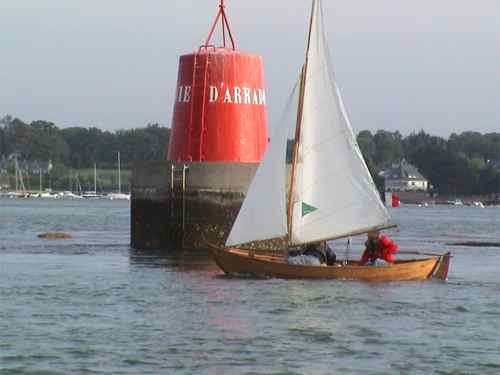 |
The bigger the boat, the more seaworthy it is. The natural home of most very small boats is the lake, harbor or sheltered estuary. Sea kayaks can cope with open sea and exposed coastlines. What other small boats are safe at sea?
For fun in good weather and survival in bad, a sea boat must cope well with breaking waves, recover fast from capsize, protect its crew, and be sturdy to avoid gear failure. It should be stable enough to let you relax, take a photo or eat a sandwich.
Most small boats being made today are designed for a gas or diesel motor and are pretty hard to move with oars, to the extent of being helpless if the propellor stops turning. They have given a generation of boaters the impression that rowing, paddling and sailing are difficult and possibly dangerous when in fact they're good exercise and a real pleasure.
Of course Kayarchy prefers boats which slip through the water so easily that a motor would be a burden. It's hard to beat a sea kayak because you can put it on the roof-rack, drive to someplace nice, go afloat for a few hours without pollution or scaring off the wildlife, and go back home. So a sea kayak gets used when anything else would be "too much trouble, I'll go for a walk". But there are other seaworthy small boats powered by sail and oar.
The big difference between a kayak and all other small boats is that the others are open boats, whereas the kayak is fully decked so that waves can surge over it but not fill it up.
An open boat still needs open space for the crew to work sails or oars, so it can't be completely immune from flooding but you can go a long way towards keeping it moving in all conditions. You can fill it up with inflatable buoyancy bags as in this Canadian canoe, or install airtight buoyancy chambers doubling as seats along both sides of the boat and in the bow. An even better alternative for plastic boats is to install a hull liner so that the bottom of the cockpit is near or above water level. See below as to racing dinghy flotation.
If a sea kayak capsizes you can roll it back up in a couple of seconds without getting much more than your head wet. Other boats usually require a soaking-wet crew to get into a position where, by hauling on a rope, they can roll the boat back upright and scramble in. A sailing yacht will (God willing) roll itself back up thanks to a large lump of lead bolted to the bottom but a yacht falls outside our definition of small boat because the owner of even the smallest needs a road trailer, a slipway and probably a helping hand to launch and recover it. There are some micro-yachts for which plans are available. The catch is that to be really seaworthy they still have to be quite heavy, but we mention the Roamer sailing dinghy and Scandinavian-style sailing canoes.
Strong winds are the big enemy of any light boat. To make progress against or across a strong wind you need either lots of power or a low, streamlined profile. The answer is often a traditional working boat design, with a few adaptations because most working boats were designed not just to be safe on open water but to carry a heavy load.
And some inspirational books. Many of these are now out of print but all are available second hand:
• Sail & Oar, John Leather, International Marine, 1982. Probably the best introduction to the subject of small boats which can be both rowed and sailed.
• Building Classic Small Craft, John Gardner, International Marine, 1996.
• The Dory Book, John Gardner, Mystic Seaport Museum, 1987.
• Anything by Uffa Fox (sailboats for cruising and racing) or Phil Bolger (boats for messing around in, from the sublime Wisp to the magnificently eccentric Micro). Mostly out of print but available secondhand.
• Thirty Wooden Boats, Forty Wooden Boats and Fifty Wooden Boats, published by WoodenBoat magazine.
• Manual of Yacht & Boat Sailing, Dixon Kemp. Written in 1878 but still the reference work on classic yachts and sailing canoes. Often re-printed by independent publishers. The chapter on sailing canoes has been reprinted as a separate book by publishers DN Goodchild but we recommend the complete modern edition revised by John Leather (Ashford Press, 1988), currently out of print but available secondhand.
• Skin Boats of Greenland, Ships & Boats of the North, H C Petersen, Viking Ship Museum, Roskilde, 1986.
• Traditional Boats of Ireland, Criostóir Mac Cárthaigh, The Collins Press, 2008.
• Sea-Boats, Oars & Sails, Conor O'Brien, Oxford University Press, 1941. Out of print, rare. Mainly about using small boats at sea but also tells how to build a curragh on a beach with minimum tools.
See also the books cited at Build Your Own Skin-On-Frame Kayak.
Many sea kayakers also have other boats. If you have a light and seaworthy rowing or sailing boat which you built yourself, we'd love to see pictures.
Alan Byde, who wrote many good canoeing / kayaking books in the 60s and 70s, once spent a few weeks on the west coast of Ireland, working with a traditional boat-builder to make a 19 foot Aran curragh which he named the St Caoman. See below.
Christopher Cunningham, editor of Sea Kayaker magazine, built himself an 18 foot William Chamberlain / John Gardner-type gunning dory. This is a beautiful, slim but fairly heavy rowing-sailing boat. It can be rowed by one or two, has excellent rough water performance under oars, and sails well in moderate winds. The design closely resembles François Vivier's Youkou-Lili. Full details are in John Gardner's book. And he also built himself a version of the Gokstad faering, for a 1100 mile rowing trip along the Inside Passage to Juneau, Alaska. See below.
Brian Schulz of www.capefalconkayak.com built himself two ravishing ultra-light Adirondack Guideboats, 13 feet and 15 feet long. Again, see below.
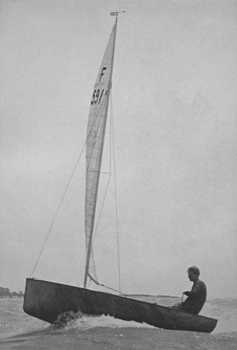 Uffa Fox, perhaps Britain's best-known designer of small boats, loved to fill a 12 foot Firefly with inflated air bags, find an equally reckless crewman and sail home through the worst sea and wind conditions the Isle of Wight had to offer.
Uffa Fox, perhaps Britain's best-known designer of small boats, loved to fill a 12 foot Firefly with inflated air bags, find an equally reckless crewman and sail home through the worst sea and wind conditions the Isle of Wight had to offer.
The Firefly is made of hot-molded wood veneer. It can be sailed by one or two people and has quite a powerful rig for a small dinghy. It's a nice boat and was very popular for many years until it was replaced by the 13 ft 10 in fiberglass International Laser shown below.
The Laser is a very nice one-person boat, although to Uffa Fox it would have looked more like a sailing surfboard than a dinghy. The hull is only about 14 inches deep and completely covered with a molded deck in which there is a small depression, like a shower tray, for the sailor's feet. When sailing, the sailor spends 95% of the time sitting on the outer edge of the deck, leaning backwards as a counterbalance to the wind in the sail, and often with his or her backside dragging in the water. A Laser's tall, powerful rig and unsinkable hull make it wild fun at sea in a Force 4 wind. One has been sailed around Britain but that must have been a very wet ride for a sailor with stomach muscles of iron.
 |
Here's a Laser launching through breaking waves. When a wave breaks over the deck, very little water stays aboard. As with most modern racing dinghies, the entire hull is a sealed buoyancy chamber. This is great except in designs which have too much flotation so they float very high, making it difficult for a crewman in the water to reach the centerboard and urging the mast underwater into a full capsize (1). |
 |
Ideally a dinghy will have just enough flotation, so the crew has plenty of space to sit and move around (2a), and when capsized the boat floats with the mast almost flat on the water (2b) so the buoyancy of the mast plus the resistance of the sail keeps it on the surface; and when the crew rights it after a capsize nearly all the water flows out of the open stern without bailing. |
Offshore sailing in any high-performance racing dinghy is asking for trouble, because the rig has a high aspect ratio. Their masts are too tall for safety in high winds and can't be taken down to make safe progress under oars. Just look at the carnage when any national dinghy sailing championship is hit by Force 5 gusts. Two rescue boats trying to retrieve thirty dinghies all either horizontal or upside down.
A sailing dinghy for use on open water, other than very near a safe harbor or beach, must have a way to reduce its sail area at sea if the wind gets strong. That's not possible with many popular classes of dinghy.
Ideally you'd be able to reduce or take down not just the sail but the mast while at sea. You can't do that with many commercial dinghies although older Mirror dinghies have a gunter rig, which means a short permanent mast which doubles in height when you put the sail up. On a traditional small sailing boat, the short mast can usually be lifted out of its socket and laid down horizontal in seconds. Traditional sailing rigs include the gaff with a high peak, and the crab claw rig as at Other Multihulls For Exposed Waters.
If you want to explore exposed coastlines in a small sailing boat, there's a lot to be said for a stable, low-performance, short-masted 11 or 12-foot dinghy. They are available new or second hand, or you can join the traditional sail revival and build your own like the Laïta design shown here.
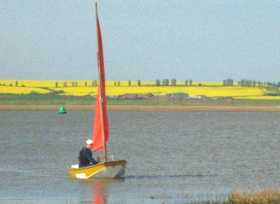 |
The Mirror is a short, cute, lightweight boat. It rows surprisingly well for a short sailing dinghy and can be sailed by one or two adults. Tens of thousands have been sold worldwide and the class association says it's "the world's most popular double handed sailing dinghy". 10 ft 10 in long, 4 ft 7 in wide, 135 lbs complete, mainsail 49 sq ft, jib 20 sq ft. It's a nice little dinghy for exploring but a bit slow for exposed coasts and the front is as flat as a boxer's nose. Rather than cut through steep, choppy waves, it slams into them and is therefore wet and slow when sailing to windward on exposed water. Awkward if home or safety lie to windward, but somebody has sailed one from Wales to the Black Sea. More images at www.usmirrorsailing.com |
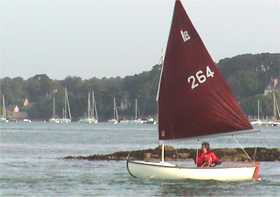 |
We really like the Lymington River Scow. It looks like a clog, is 11 ft 4 in long and 4 ft 11 in wide, weighs 220 lbs in fiberglass, takes one or two, and carries a 68 square foot mainsail and a 12 square foot jib. See www.johnclaridgeboats.com |
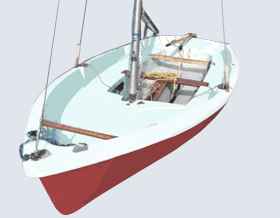 |
Or there's the Otter, 12 ft long, 4 ft 11 in wide, takes two, 56 square foot mainsail, 19 square foot jib. A nice boat, difficult to capsize even if you accidentally let go of both sheet and tiller during a strong gust (done that) but it's getting a bit big and heavy to haul up a strange beach in gathering darkness, and it has a tall one-piece mast so you can't take down the top half in windy conditions. Boats like this are sometimes the only things out on the water on a windy day. Jib down, two reefs in the mainsail, surfing on storm waves. If there is too much or too little wind, you can drop the sail and gaff, and get the oars out. |
Some small sailing boats are capable of self-righting after a capsize, which is a great safety feature but is usually achieved by attaching a lump of lead to the bottom. An honourable mention for Eric Coleman's Roamer design which is an ordinary 14 foot family sailing dinghy except that it has watertight buoyancy tanks extending above the usual deck level, 76 pounds of lead attached to the bottom and a metal centreplate weighing a further 80 pounds. Total weight 600 pounds. About two hundred have been home-built around the world. For more information have a look at the Small Boat Forum download www.smallboatforum/PDFfiles/roamercruisingdinghy.pdf
For more information about beach cruising under sail see Sailing Canoes For Exposed Waters and the Dinghy Cruising Association website at www.dca.uk.com
When rowing you use all your muscles including the powerful ones in the legs, and you apply all this power using two long levers. Pure rowing boats are not stable enough to carry a sailing rig, but see Rowing-Sailing Boats.

The most seaworthy rowing boat designs in America are tested in an open-water race, the Blackburn Challenge which goes 22 miles round Cape Ann, Massachusetts. www.blackburnchallenge.com
Rowing & kayaking compared
A good rowing boat like the Adirondack Guideboat above can be much faster than a sea kayak, and carry a heavier load. It keeps you further up out of the water than a kayak. It's drier and has more space. You can take a friend. You can change position, spread out, drop anchor, do some fishing, pour a glass of wine, relax and enjoy fine weather.
A kayaker would say that no small boat protects its crew from wind and spray the way a kayak does. An experienced sea kayaker is quite happy in a Force 4, can make progress in a Force 5, and for a time can go in a Force 6. See Beaufort Scale For Kayakers. A strong wind affects a one-person or two-person rowing boat more than a kayak because the rowing craft have higher sides and a less streamlined profile. Light rowing boats without ballast are often hard to control by the time the wind reaches Force 4. The addition of ballast such as a load of camping equipment, food and water goes a long way towards curing this.
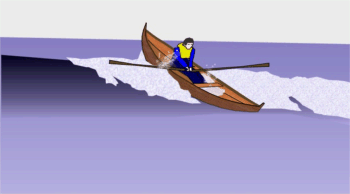 Rowing boats are much less likely to capsize but any small boat can capsize through wave action. A kayaker can roll straight back up - the crew of a rowing boat is, at best, in for a frantic couple of minutes. Getting the water out of a flooded rowing boat in heavy seas is difficult. A sea kayak could quite easily get out through this wave, but to tackle it in a small open rowing boat means a risk of swamping, capsize, lost equipment, broken oars and fractured ribs.
Rowing boats are much less likely to capsize but any small boat can capsize through wave action. A kayaker can roll straight back up - the crew of a rowing boat is, at best, in for a frantic couple of minutes. Getting the water out of a flooded rowing boat in heavy seas is difficult. A sea kayak could quite easily get out through this wave, but to tackle it in a small open rowing boat means a risk of swamping, capsize, lost equipment, broken oars and fractured ribs.
A rowing boat is heavier and bulkier than a kayak and a good one is a lot more expensive. Most rowing boats require a dolly to get them in and out of the water, and either a trailer or two strong people to get them onto a roof rack.
And of course when rowing a boat, you face the wrong way so you have to look over your shoulder a lot. Unless you stand up to row like a Maine lobsterman in his peapod or you fit the ingenious Frontrower system designed by Ron Rantilla. www.frontrower.com. This highly efficient unit can be fitted to Canadian canoes and similar boats up to 36 inches wide. Remember the little swamp boat in the Tommy Lee Jones / Wesley Snipes movie US Marshals?
Here are some traditional and modern approaches to the question of the seaworthy rowing boat:
Ireland's west coast is exposed to the full force of north Atlantic gales and their legacy of big waves. The local solution is the currach, curach or curragh. These canvas-covered rowing boats come in a range of shapes and sizes from a two-person "canoe" 16 ft 6 in long, up to a 27-foot naomhog which needs four crew, can carry a ton of livestock or building materials but may weigh as little as 200 pounds.

Curraghs can be seen in the old practice of harpooning basking sharks in the film Man of Aran (director Robert J Flaherty, 1934, re-released 1977). Easier to find and a lovely film itself is The Secret Of Roan Inish (director John Sayles, 1994) where you can see a curragh under oars on calm water.
Click here for Alan Byde's article about building his three-man Aran currach. There's a long section on curraghs in the heavyweight book Traditional Boats of Ireland, Criostóir Mac Cárthaigh (The Collins Press, 2008) from the Traditional Boats of Ireland Project. The Lough Neagh Boating Heritage Association has a nice website with technical information and some lovely photos at www.loughneaghboats.org
All currachs are slim and very light for their size, and they are astonishingly cheap and quick to build using skin-on-frame construction. For a curragh, that means a framework of long, thin wood battens covered with 12-18 oz cotton canvas.
Recreational curraghs are still coated with tar to protect the canvas and keep it waterproof. Roofer's liquid bitumen has been tried because you can buy it anywhere at a reasonable price, but it tends to shrink and pull the skin away from the frame. The solution is either Tuskar Tar if you can get it, or a mix of hot coal tar and natural pitch from pine trees, sold as Stockholm tar or Archangel tar. According to Traditional Boats of Ireland "about a fistful of pitch is needed for a gallon (circa 4.5 l) of coal tar". We were recently told that coal tar is banned in the Republic of Ireland because it is carcinogenic, but curragh builders are still permitted to import it. In hot weather the tar gets onto your clothes and spoils them. Partly for that reason and partly because extra strength is useful when your curragh has an outboard motor "all existing working curachs [on Aran and in County Mayo and north Connemara] are covered with fibreglass". Source - Traditional Boats again.
When a small currach gets to the beach, the crew flip it upside down, put it over their heads and walk up the beach like a four-legged beetle. Most currachs have very high rocker to help them rise over steep waves, often to the extent of looking like a giant black banana. The hull cross-section is remarkably rounded, showing that it is intended for rowing, not sailing. On the rare occasions when they are sailed, steering is done with an oar over the stern. They have no centerboard or keel. This makes them maneuverable in rough water and means that if they get hit from the side by a breaking wave, they slide sideways rather than tripping up and capsizing. They are occasionally fitted with a leeboard but cannot really be sailed upwind.
Curraghs are superb sea boats but it takes two or more experts to row them in difficult conditions. Here's a passage from The Aran Islands by J M Synge (1907): "When we had gone about a hundred yards they ran up a bit of sail in the bow, and the pace became extraordinarily rapid. The shower had passed over and the wind had fallen but large, magnificently brilliant waves were rolling down on us at right angles to our course. Every instant the steersman whirled us around with a sudden stroke of his oar, the prow reared up and then fell into the next furrow with a crash, throwing up masses of spray. As it did so the stern in its turn was thrown up and both the steersman, who let go of his oar and clung with both hands to the gunnel, and myself, were lifted high above the sea. The wave passed, we regained our course and rowed violently for a few yards, then the same manoeuvre had to be repeated. As we worked out into the sound we began to meet another class of waves, that could be seen for some distance towering above the rest. When one of these came in sight the first effort was to get beyond its reach. The steersman began crying out in Gaelic 'Siubhal, siubhal' ('Run, run') and sometimes, when the mass was gliding towards us with horrible speed, his voice rose to a shriek. Then the rowers themselves took up the cry and the curagh seemed to leap and quiver with the frantic terror of a beast till the wave passed behind it or fell with a crash beside the stern."
Another boat with a long ancestry.
When sailing schooners fished for cod in the stormy waters of the Grand Banks in the north Atlantic, they carried many little dory boats. For cheap construction and efficient storage on the schooner's deck, the dories were built with a wide flat bottom, high flaring sides, and a tall thin transom which slopes sharply backwards. The design meant that one dory would nest in another and they could be stacked half a dozen high, like empty crates. They turned out to be surprisingly seaworthy. To see them in action, see the classic movie Captains Courageous (Freddie Bartholomew, Spencer Tracy, 1937). There are many stories of lost dories which survived a night in an Atlantic winter gale and were picked up by the schooner the next day with the one- or two-man crew nearly dead of cold.
A dory usually has high sides which keep its crew dry and make it excellent in rough water, but mean that in strong winds it will blow around like a weathercock unless weighted down with two crew and two hundred pounds of cod. Even the senior editor of WoodenBoat magazine says"unballasted Banks dories are notorious for their vicious motion in steep seas... and for a generally cranky nature".
The basic dory evolved into many leisure designs in in the 19th century. Some kept the simple cross-section of the Banks dory which consists of just three straight lines. Modern rowing versions for simple construction in plywood include the lovely and popular Bolger Light Dory / Gloucester Gull. The Banks dory also evolved in another direction. The cross-section was made rounder and the flat bottom narrowed to a single plank, which produced some very nice rowing-sailing dories .
Dories of all shapes and sizes are very popular in north America and France. To find out more, see The Dory Book mentioned above, and:
• The Dory - A Practical Guide to Some Build-Able Beach Cruisers. Thom Vetromile. This is a free download. Last time we looked, the link was www.scribd.com/doc/69485143/Dory-Story
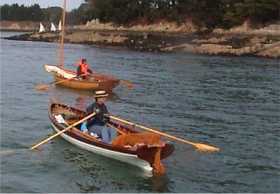 These boats evolved in America in the 18th and 19th centuries from a mixed heritage in which it is possible to trace the Canadian canoe, the Banks dory and others.
These boats evolved in America in the 18th and 19th centuries from a mixed heritage in which it is possible to trace the Canadian canoe, the Banks dory and others.
Some, for example the Whitehall boat, closely resemble the smaller boats carried aboard 18th century sailing ships. Seen at a rally of traditional boats in the Golfe du Morbihan, France, the boat in the foreground is a fast, elegant rowing boat. It has a vertical stem with a very fine, knife-shaped entry, and a wineglass-shaped stern. It is fast, particularly with two people rowing, but with its high sides and high rowing position and slim bow it is not suitable for really exposed waters.
The Adirondack Guideboat sketched at the start of this section has a low rowing position and is more seaworthy than a Whitehall boat of equivalent size. The images on this page don't do justice to the Guideboat (sorry) which is one of the most beautiful small boats. At first glance it looks like a Canadian canoe with oars, but it has the flat bottom plank of a dory and a knife-shaped bow and stern recalling the bow of a Whitehall boat. Guideboats were designed for fishing guides to take a single client out onto lakes after trout. They had to be light so as to be easily carried from lake to lake, and fast enough to satisfy a rich, demanding client from the city.

Typically about 16 feet long and 39 inches wide, they are just wide enough for a decent pair of oars without the need to put the rowlocks on outriggers, although you do have to cross your hands during the stroke.
Guideboats are narrow at the waterline so they are easily driven but have low initial stability. In other words, they feel tender. Standing up in an unballasted Guideboat is a balancing act. However they have high secondary stability from the outward flare of the sides of the hull.
As with a Canadian canoe, Guideboat hulls are quite high and prone to catch the wind. Strong side winds are a problem for them, but they can make good upwind progress because rowing is much more effective than paddling. The moderator of the Small Boat Forum says "the Guide-Boat for solo human-powered beach camping is second to none... In the 14 to 16 ft range the ability of this boat to carry gear and travel over the water at a steady clip through all kinds of weather is renowned... in almost all conditions adding some ballast helps the handling of the boat. It can be camping gear OR sand or rocks picked up at the launch site".
Many daring coastal journeys have been made in the USA in similar boats rowed by one or two people. The St Lawrence River Skiff has almost the same cross-section as the Adirondack Guideboat and is often the same length but has also been made in longer versions, some as much as 23 feet long. Extra length rather than extra width gives them enough weight and stability to sail well on open water, if the sail is small and the crew are careful.
In the USA you can buy a re-creation in cedar or kevlar of the Adirondack Guideboat (www.adirondack-guide-boat.com) or the more Whitehall-shaped Rangeley Lakes boat (www.rangeleyboats.com). And there are boats with similar performance but less traditional appearance, such as the Appledore 16, formerly the Appledore Pod, from Alden (www.rowalden.com) and the Skua from Middle Path Boats (www.by-the-sea.com/middlepathboats).
There are nice plywood kits for boats such as the Andrew Wolstenholme / Jack Chippendale Sprite from Seabird Boats (www.seabirdboats.co.uk) and Wayland Marine's Merry Wherry (www.merrywherry.com); and there are home-build plans for nice designs like the Bee and Linnet from Woods Designs (www.sailingcatamarans.com), and the Flashboat from Paul Gartside (www.gartsideboats.com).
If you like the idea of skin-on-frame construction (SOF boats are easy for amateurs to build at home, incredibly quick to build, light enough to hold in the air above your head, and much tougher than you'd think) there are some nice rowing boats on these two sites:
• Cape Falcon Kayaks. Features Adirondack guideboats in 13 foot and 15 foot lengths as well as Greenland kayaks, Canadian canoes and a Pacific outrigger canoe. www.capefalconkayak.com
• Gentry Custom Boats. Dave Gentry's own design for Ruth, an 18-foot rowing wherry, plus a Greenlander and a child's kayak. www.gentrycustomboats.com
Click here for more about skin-on-frame construction.
And although it is beyond most people's resources, we have to mention one of the most beautiful, the slim 22 foot faering which was excavated from the Viking ship burial at Gokstad, Norway. Some fine replicas have been built, in particular one by Svein Erik Øya which is based at Sandefjord, home of the Gokstad kystlag or ship guild (http://home.online.no/~joeolavl/viking/gokstadfaering.htm).
Touring shells, also called recreational shells, are about 18 feet long for a one-person boat. They look like the rowing skiffs used for flat water racing but are intended for use on open water so their hulls are a bit wider and more stable. However they are still less than 39 inches wide, which is about the minimum distance between rowlocks, so as with rowing skiffs the rowlocks have to be on the end of metal frames bolted to the sides of the hull (outriggers).
Touring shells usually have unsinkable hulls made of plastic composites, like a skinny version of the International Laser dinghy. Sometimes they have deck hatches to give dry stowage for camping equipment. The hulls of the Echo and Islander from Echo Rowing are as narrow as sea kayak hulls. At 52 and 63 lbs fully rigged, they can be lifted and carried by one strong person. www.echorowing.com.
A touring shell's sliding seats and outrigged oars give it real speed but the outriggers make it hard to get in and out, except alongside a dock of exactly the right height. To help overcome this, Echo Rowing have a patented folding outrigger system. The rigger arms are designed to disintegrate progressively if excessive force is applied to them, for example if the shell is capsized by wave action. "First the E-clip will break if the force is upward, next the mounting bracket should tear, and finally the mounting bolts should pull out with repairable localized damage". The rowing position is great for estuaries, and for the coast in fine summer weather.
| Go to next page for: • Rowing-Sailing Boats • Sailing Canoes For Exposed Waters • Pacific Outrigger Canoes • Other Multihulls For Exposed Waters • Yachts & Sea Kayaks |